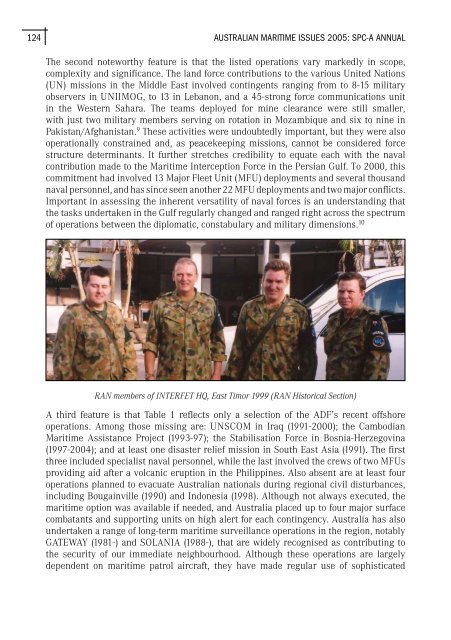Australian Maritime Issues 2005 - Royal Australian Navy
Australian Maritime Issues 2005 - Royal Australian Navy
Australian Maritime Issues 2005 - Royal Australian Navy
You also want an ePaper? Increase the reach of your titles
YUMPU automatically turns print PDFs into web optimized ePapers that Google loves.
124<br />
AUSTRALIAN MARITIME ISSUES <strong>2005</strong>: SPC-A ANNUAL<br />
The second noteworthy feature is that the listed operations vary markedly in scope,<br />
complexity and significance. The land force contributions to the various United Nations<br />
(UN) missions in the Middle East involved contingents ranging from to 8-15 military<br />
observers in UNIIMOG, to 13 in Lebanon, and a 45-strong force communications unit<br />
in the Western Sahara. The teams deployed for mine clearance were still smaller,<br />
with just two military members serving on rotation in Mozambique and six to nine in<br />
Pakistan/Afghanistan. 9 These activities were undoubtedly important, but they were also<br />
operationally constrained and, as peacekeeping missions, cannot be considered force<br />
structure determinants. It further stretches credibility to equate each with the naval<br />
contribution made to the <strong>Maritime</strong> Interception Force in the Persian Gulf. To 2000, this<br />
commitment had involved 13 Major Fleet Unit (MFU) deployments and several thousand<br />
naval personnel, and has since seen another 22 MFU deployments and two major conflicts.<br />
Important in assessing the inherent versatility of naval forces is an understanding that<br />
the tasks undertaken in the Gulf regularly changed and ranged right across the spectrum<br />
of operations between the diplomatic, constabulary and military dimensions. 10<br />
RAN members of INTERFET HQ, East Timor 1999 (RAN Historical Section)<br />
A third feature is that Table 1 reflects only a selection of the ADF’s recent offshore<br />
operations. Among those missing are: UNSCOM in Iraq (1991-2000); the Cambodian<br />
<strong>Maritime</strong> Assistance Project (1993-97); the Stabilisation Force in Bosnia-Herzegovina<br />
(1997-2004); and at least one disaster relief mission in South East Asia (1991). The first<br />
three included specialist naval personnel, while the last involved the crews of two MFUs<br />
providing aid after a volcanic eruption in the Philippines. Also absent are at least four<br />
operations planned to evacuate <strong>Australian</strong> nationals during regional civil disturbances,<br />
including Bougainville (1990) and Indonesia (1998). Although not always executed, the<br />
maritime option was available if needed, and Australia placed up to four major surface<br />
combatants and supporting units on high alert for each contingency. Australia has also<br />
undertaken a range of long-term maritime surveillance operations in the region, notably<br />
GATEWAY (1981-) and SOLANIA (1988-), that are widely recognised as contributing to<br />
the security of our immediate neighbourhood. Although these operations are largely<br />
dependent on maritime patrol aircraft, they have made regular use of sophisticated

















